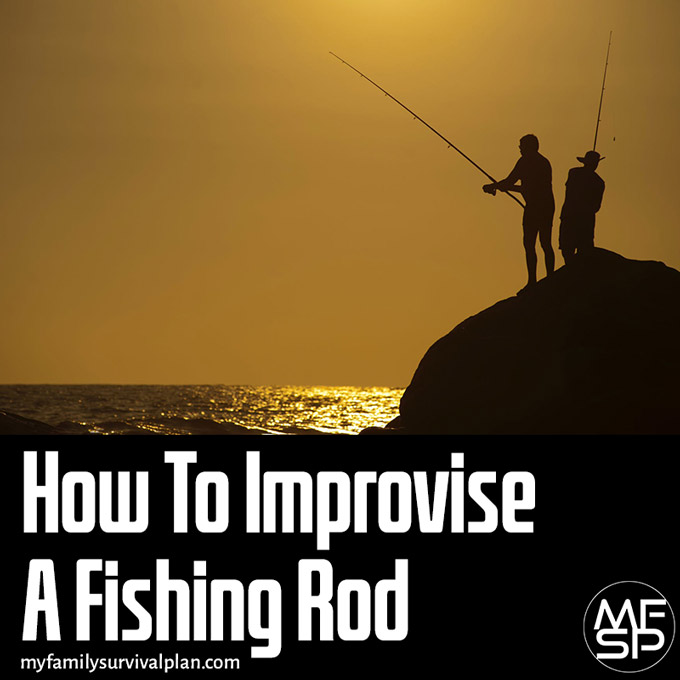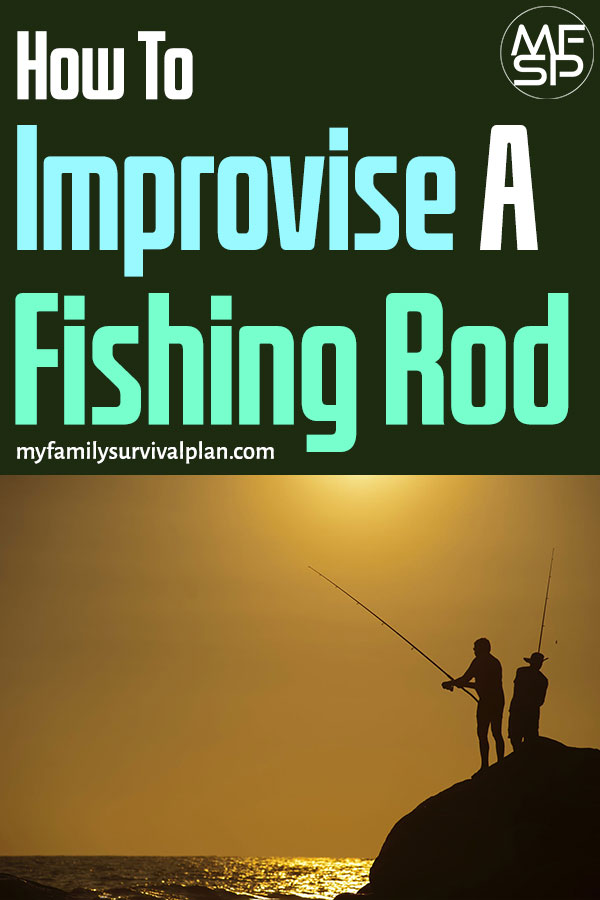Click Here To Join Our Telegram Channel for FREE daily tutorials!

How To Improvise A Fishing Rod. Photo – Pexels (PD)
Every serious fisherman knows the importance of owning the right fishing rod. Whether you’re fishing for sport or you’re simply trying to feed yourself, there’s no better way than doing it the old-fashioned way. But in an SHTF situation (whether you’re lost in the wilderness or you’ve found yourself trapped in an end-of-days scenario) you might not have you trusted fishing rod on you. But you won’t necessarily need to. You’ll need nothing more than a knife; having a small tackle box with the right assortment of hooks and some spool of monofilament will make things easier. If you’re lucky enough to have these items on you, you’ll need to improvise the fishing pole only, which it’ll be more than enough to feed yourself in desperate times. If not, well, you’ll need to improvise the whole thing. The rest of the materials you can easily find in your surroundings. And here’s how to do it.
The Pole
 The first thing you’ll need to find is the pole; any 6 – 7 foot-long branch will do, as long as it’s no thicker than a human thumb. Once you’ve found the right one, you’ll have to break it off from the tree. Once this is achieved, you’ll need to break it again to the desired length. If it’s dry enough, you can snap it in half against your knee or against any hard surface; but if it’s not dry and it’s still rather flexible, you can try cutting it with the knife. Using dead branches is a bad idea because their durability is very low and break easily. You can test the tip by banding it to the point of snapping. If it snaps, fine; the more it does snap, the stronger the remaining pole gets. As soon as you got the pole to the desired length, use the knife to remove any remaining branches, leaves or shoots. Make it as smooth as possible in order to improve weight and handling.
The first thing you’ll need to find is the pole; any 6 – 7 foot-long branch will do, as long as it’s no thicker than a human thumb. Once you’ve found the right one, you’ll have to break it off from the tree. Once this is achieved, you’ll need to break it again to the desired length. If it’s dry enough, you can snap it in half against your knee or against any hard surface; but if it’s not dry and it’s still rather flexible, you can try cutting it with the knife. Using dead branches is a bad idea because their durability is very low and break easily. You can test the tip by banding it to the point of snapping. If it snaps, fine; the more it does snap, the stronger the remaining pole gets. As soon as you got the pole to the desired length, use the knife to remove any remaining branches, leaves or shoots. Make it as smooth as possible in order to improve weight and handling.
The Fishing Line
If you happen to have some monofilament fishing like on you, your job gets much easier. If you don’t, sewing thread could get the job done as well. But in sewing thread isn’t an option either, you’ll need to get your hands dirty and look for thin green vines in ground cover or in the undergrowth found around various bushes. The greener the vine, the stronger it will be. If you find a vine that’s about 10 feet, look no further. Remove any tendrils by pulling carefully so you don’t damage the line. For safety, the line should be tied midway down the pole and wrapped as many times as possible towards the tip, where a simple overhand knot will suffice for holding it in place. This way, if the pole breaks, you can immediately catch the line with your hands.
The Hooks And The Bait
 Some professional hooks will work extremely well, provided of course you brought some along. If not, you can always use paper clips, safety pins or soda can tabs. Another viable option is to carve your very own V-shaped hooks out of wood (green wood preferably). At one end you’ll need to carve a groove, in the hook-eye area. This will allow you to tie the fishing line onto. As bait you can use pretty much any insect you can get your hands on. The easiest things to get are the earthworms, which can be found underground, under rocks, around moss, and in other moist areas. Once you’ve baited the hook, you’re pretty much ready to go. From here on in it’s all about patience and skill.
Some professional hooks will work extremely well, provided of course you brought some along. If not, you can always use paper clips, safety pins or soda can tabs. Another viable option is to carve your very own V-shaped hooks out of wood (green wood preferably). At one end you’ll need to carve a groove, in the hook-eye area. This will allow you to tie the fishing line onto. As bait you can use pretty much any insect you can get your hands on. The easiest things to get are the earthworms, which can be found underground, under rocks, around moss, and in other moist areas. Once you’ve baited the hook, you’re pretty much ready to go. From here on in it’s all about patience and skill.
When it comes to fishing is a SHTF / TEOTWAWKI situation, fishing areas are very important. It’s absolutely necessary to procure the maximum amount of fish with as little resources as possible. So it’s not all about the gear that you have or that you’ve crafted. It’s just as important to know where, when and how to fish. If you’re fishing in stagnant waters, you’ll need to go after still pools. The stillness of the water will make the bait as visible as possible, thus increasing your chances of catching something fast. When it comes to running waters, the area behind exposed boulders would be the best location to catch anything, as fish have a tendency of gathering in such places. You might also want to consider bank fishing, as standing on the water’s edge can also be a very productive fishing method.
As you can see, improvising the entire fishing pole is a rather difficult task, but not impossible to achieve. As previously stated, having line and hooks on you will spare you a lot of trouble. But if not, you’ll just need to put some extra effort into it. Just follow all the steps and you’ll have your DIY fishing rod in no time.
Image For Pinterest:

How To Improvise A Fishing Rod. Photo – Pexels (PD)
This Crazy Off Grid Device Literally Makes Drinkable Water From Fresh Air:
According to NASA, the U.S. is expecting a 100-YEAR LONG MEGADROUGHT.
It's already begun. Ask the farmers in California. They know.
Every survivalist knows that water is of critical importance. You NEED an independent water source that you can count on!
As an interesting "survival rehearsal" - imagine that you turned the tap on right now and nothing came out. How long would you last?
But what if there was another water source literally hidden in plain sight. That's right, I'm talking about the atmosphere!
The amazing thing about getting water from the natural moisture in the air... is that it is ALWAYS available.
This gives you real water security!
Learn more about how to tap into "Nature's secret water reservoir" and stay hydrated when TSHTF!
Watch the video:
😳 What Tinnitus Does To Your Brain Cells (And How To Stop It)
After 47 years of studies and countless brain scans done on more than 2,400 tinnitus patients, scientists at the MIT Institute found that in a shocking 96% of cases, tinnitus was actually shrinking their brain cells.
As it turns out, tinnitus and brain health are strongly linked.
Even more interesting: The reason why top army officials are not deaf after decades of hearing machine guns, bombs going off and helicopter noises…
Is because they are using something called "the wire method", a simple protocol inspired by a classified surgery on deaf people from the 1950s...

I Can't Help Showing This Off:
If you haven't heard of Claude Davis yet do yourself a huge favor and watch this video.
One of the smartest guys I ever had the pleasure of meeting, Claude set-up a unique prepping system that changed his life forever.
I already tried it myself and let me tell... you I was completely blown away... His surprising tactics could make your life easier and give you the peace of mind you deserve.
Don't just take my word for it... watch his short video and decide for yourself.

Most People Don't Have The Guts To Try This:
An amazing discovery in an abandoned house in Austin, Texas: A lost book of amazing survival knowledge, believed to have been long vanished to history, has been found in a dusty drawer in the house which belonged to a guy named Claude Davis.
Remember... back in those days, there was no electricity... no refrigerators... no law enforcement... and certainly no grocery store or supermarkets... Some of these exceptional skills are hundreds of years of old and they were learned the hard way by the early pioneers.
>> Click here to find out about them now
We've lost to history so much survival knowledge that we've become clueless compared to what our great grandfathers did or built on a daily basis to sustain their families.
Neighbors said that for the last couple of years Claude has tried to unearth and learn the forgotten ways of our great-grandparents and claimed to have found a secret of gargantuan proportions. A secret that he is about to reveal together with 3 old teachings that will change everything you think you know about preparedness:
>>> Click Here To Watch His Short Video <<<

More Off-Grid And Survival Resources:

What REALLY Happens When You Bury a Shipping Container? (Hint: It's A Bit Crazy...)
Shipping containers are all the rage - but if you are thinking about buying one, you MUST watch this video first:
There's a general belief that if you bury a shipping container you can create an awesome root cellar / storm shelter / survival bunker.
But is a shipping container strong enough to handle the pressure?
Watch the video to see what happens:
What Really Happens When You Bury a Shipping Container? (Click To Watch Video)












